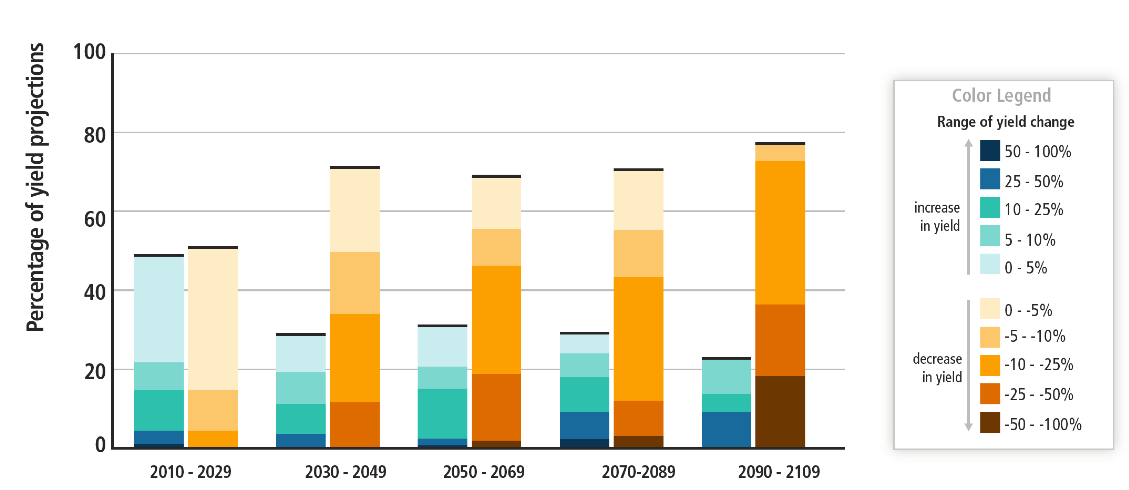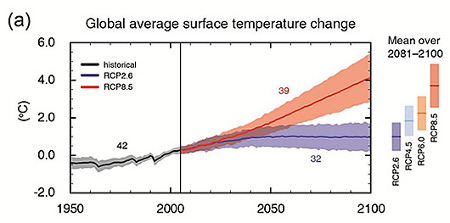
The Intergovernmental Panel on Climate Change has just published its latest Working Group II report detailing impacts, adaptation, and vulnerability associated with climate change. The picture it paints with respect to the consequences of continued climate change is rather bleak.
For example, the report discusses the risk associated with food insecurity due to more intense droughts, floods, and heat waves in a warmer world, especially for poorer countries. This contradicts the claims of climate contrarians like Matt Ridley, who have tried to claim that rising carbon dioxide levels are good for crops.
While rising carbon dioxide levels have led to 'global greening' in past decades and improved agricultural technology has increased crop yields, research has indicated that both of these trends are already beginning to reverse. While plants like carbon dioxide, they don't like heat waves, droughts, and floods. Likewise, economist Richard Tol has argued that farmers can adapt to climate change, but adaptation has its costs and its limits. In fact, the IPCC summary report notes that most studies project a decline in crop yields starting in 2030, even as global food demand continues to rise.
Summary of projected changes in crop yields, due to climate change over the 21st century. Yellow indicates studies that project crop yield decreases, blue indicates studies projecting increases. From IPCC AR5 WGII SPM.
The report also discusses risks associated with water insecurity, due for example to shrinking of glaciers that act as key water resources for various regions around the world, and through changing precipitation patterns. As a result of these types of changes, the IPCC also anticipates that violent conflicts like civil wars will become more common.
The number of people exposed to river floods is projected to increase with the level of warming over the remainder of the century. Sea-level rise will also cause submergence, flooding, and erosion of coastal regions and low-lying areas. And ocean acidification poses significant risk for marine ecosystems; coral reefs in particular.
The general risk of species extinctions rises as the planet warms. More climate change means that suitable climates for species shift. The faster these climate zones shift, the more species will be unable to track and adapt to those changes.
"Many species will be unable to track suitable climates under mid- and high-range rates of climate change (i.e., RCP4.5, 6.0, and 8.5) during the 21st century (medium confidence). Lower rates of change (i.e., RCP2.6) will pose fewer problems."
The report also estimates that global surface warming of approximately 2°C above current temperatures may lead to global income losses of 0.2 to 2.0 percent. However,
"Losses are more likely than not to be greater, rather than smaller, than this range ... few quantitative estimates have been completed for additional warming around 3°C or above."
Even in the IPCC's most aggressive greenhouse gas emissions reductions scenario, we only limit global warming to around 1°C above current temperatures. In a business-as-usual scenario, temperatures warm about another 4°C – yet we have difficultly estimating the costs of warming exceeding another 2°C. In other words, failing to curb human-caused global warming poses major risks to the global economy.

Nevertheless, there will be a certain amount of climate change that we won't be able to avoid, and the IPCC report notes that adaptation to those changes is also critically important. However, we first need to accept the scientific reality of human-caused climate change in order to plan for what's to come.
As a notable counter-example, the state of North Carolina recently introduced a bill that would require state coastal planning to ignore all new scientific research with regards to sea-level rise. Obviously we can't adapt to threats if we deny their existence. However, the IPCC report notes that many governments are already beginning to take steps to adapt to climate change impacts in their regions.
The good news is that the IPCC reports that many of these climate risks can be reduced by cutting greenhouse gas emissions and thus avoiding the worst climate change scenarios. The IPCC states with high confidence that risks associated with reduced agricultural yields, water scarcity, inundation of coastal infrastructure from sea-level rise, and adverse impacts from heat waves, floods, and droughts can be reduced by cutting human greenhouse gas emissions.
In the end it all boils down to risk management. The stronger our efforts to reduce greenhouse gas emissions, the lower the risk of extreme climate impacts. The higher our emissions, the larger climate changes we'll face, which also means more expensive adaptation, more species extinctions, more food and water insecurities, more income losses, more conflicts, and so forth.
Contrarians have tried to spin the conclusions of the report to incorrectly argue that it would be cheaper to try and adapt to climate change and pay the costs of climate damages. In reality the report says no such thing. The IPCC simply tells us that even if we manage to prevent the highest risk scenarios, climate change costs will still be high, and we can't even grasp how high climate damage costs will be in the highest risk scenarios.
Posted by dana1981 on Monday, 31 March, 2014
 |
The Skeptical Science website by Skeptical Science is licensed under a Creative Commons Attribution 3.0 Unported License. |